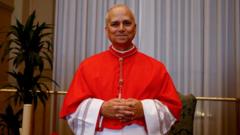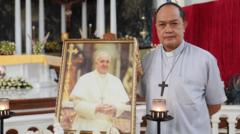On May 8, 2025, the conclave of cardinals experienced another unclear ballot as the search for a new pope continues, amidst a backdrop of historical tensions within the Church and the unique dynamics of this assembly.
Conclave Continues: Cardinals Face Delays in Selecting New Pope

Conclave Continues: Cardinals Face Delays in Selecting New Pope
As black smoke signals further inconclusive voting, anticipation builds in Vatican City for the election of a new pope.
Black smoke billowed from the chimney of the Sistine Chapel on Thursday, May 8, 2025, indicating the cardinals have yet to reach a consensus on who will be the next pope. This marks the second day of voting in a conclave that began following the death of Pope Francis in April. As crowds gathered in St. Peter’s Square, the somber atmosphere reflected the weight of decision-making that rests on the 133 cardinals, whose collective choice will shape the future of the Catholic Church.
The wait has proven difficult, with many observers expressing a blend of anticipation and disappointment following the morning's first ballot. The ceremony proceeded amid strict secrecy, a hallmark of the conclave process, as the cardinals took to their task without any communication with the outside world. Gathered in the historic chapel, they will continue to vote until a candidate garners the necessary two-thirds majority.
The event is notable not only for its scale—the largest conclave of its kind—but also for the ideological divisions within the Church. The progressive and conservative factions, both highlighting differing priorities, are playing a significant role in the choice of the next pontiff. The ideologies represent conflicting views on inclusivity versus tradition, creating a notable atmosphere around the voting process that has drawn global attention.
A crucial parameter in selecting the next leader is the age of potential candidates. Many cardinals reflect that with advancements in health care, a pope in their early 60s could potentially serve for many years, drawing them to consider candidates who can provide stability and continuity for the faithful. The preceding complexities of age and health are combined with overarching values regarding church governance—they mark important considerations that weigh heavily on participants throughout this historical moment.
As the cardinals gear up for further sessions, rumors surface regarding which candidates may emerge as the strongest options. With the conclave’s future unclear, decisions made in this pivotal period will undoubtedly resonate across the globe, influencing the lives of Catholic faithful for years to come. As the world watches, the smoke signals the ongoing deliberation, emphasizing patience in this revered tradition.






















